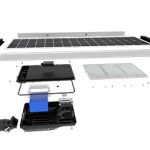what debugging of solar street lights is necessary before installing?

When installing solar street lights, do the debugging of solar street lights first and don’t leave any hidden dangers after installation.
debugging of solar street lights
Before installing solar street lights, it is best to do some simple debugging work to ensure that the solar panels, batteries, LED light sources and controllers are operating normally.
If these problems are discovered after installation, readjustment and replacement will only increase the difficulty and cost of the work. This can mainly be debugged by setting the controller. So, how to do it specifically?
Mode adjustment classification
Pure light control mode
If it is during the day, you can set the parameters and use opaque objects to block the solar panels and reduce the light intensity to the starting point.
After a 10-minute delay time, if the LED light source glows normally, it means that the solar street light function is normal, otherwise it will fail. You need to recheck the controller settings or see if there is any problem with the LED light source itself.
Under the premise that the LED light source can emit light normally, remove the obstruction of the solar cell module, the light intensity rises to the starting point, after a 10-minute delay time, confirm the shutdown signal and then the ratio output, the load stops working, and the light source should go out normally. This shows that its light control function is normal.

Light control + time control
Its startup process should be the same as that of pure light control. It will turn on when the light intensity drops to the startup point, but the shutdown process is based on the set time, usually 1 to 14 hours. Under normal circumstances, the lighting time should not be If the value is less than the set value, it can only be equal to or less than the design value, otherwise it will affect the lighting and reduce its service life.
manual mode
In this mode, the starting and closing process of the light source should not be affected by the light signal. The light source can be turned off or on manually at night or during the day. It is often used in some special loads or debugging situations.
debug mode
In this mode, if there is no light signal, the load will be turned on, and if there is light signal, the load will be turned off. It is used during system debugging, and can be used to conveniently check the correctness of the system installation during installation and debugging.
Normally open mode
This mode is suitable for loads that need to be powered on 24 hours a day, so that the powered load is always in the output state.
Only by debugging these components can you avoid unnecessary trouble when installing solar street lights later.
Author

ZGSM Solar
We are a professional solar street light manufacturer with a 20-year history.






